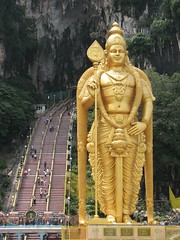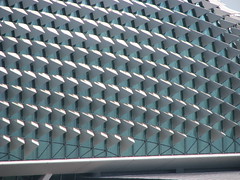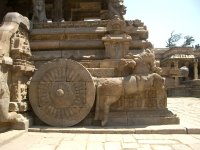
This picture of Gandhi Mandapam through the gate was taken by me in 1966 when I was a student of Engineering at the AC Colelge of Technology which was just opposite to this. The camera was a heirloom Kodak Duaflex. This is a hip level viewing twin lens reflex camera, focus free and fixed exposure (+bulb). It take 12 exposures In sqare format (6cm x 6cm) on a 620 size roll film.The film itself was 6cm x 72 cm and some other cameras use the same film in different formats - 8 exposures of 6cm x 9 cm or 16 exposures of 4.5cm x 6 cm .
Click here to view an image of the camera

( a contact print)
Only B&W films were available in India then. 620 size film also was not very common, but it was identical to 120 film but for the spool. I used to save old 620 spools and request the studio to rewind 120 film on 620 spools, if the latter was not available. see: http://camerapedia.wikia.com/wiki/620_film
Flash: Photogrphy itself was a luxury then. Flash for an amateur was the ultimate. We had disposable flash bulbs which had a long filament coiled inside a bulb. The flash bulbs were very expensive and many may be wasted due to mistakes of the photographer or the manufacturer. sometimes the ejector mechanism in th eflashholder may not work and one had to wait till the fused bulb to cool before replacing for the next shot. I never tried them anyway.
Periodicals: We had no access to any magazine dedicated to photography. If you were lucky some friend or relative would give you a foreign photo journal which was as prized a possession as a smuggled copy of 'Playboy'
Agfa India used to bring out a small newsletter with useful tips. Though this was free, the distributors were relcutant to give out to bumbling young amateurs.
Journals like 'Illustrated Weekly of India' had works of leading photographers. I remember the works of Krishnan and his wild life. fortunatley I had access to old issues of 'Life' and 'National Geographic' from my uncle's collection.
Double exposure:since Duaflex had a manual advance (like all cameras then) many times you end up with multiple exposures on single frame accidentally. Occasionally,you can put this to creative use too.
Cost: Every roll of film which we exposed over several months, used to put a big hole in our allowances and we often felt guilty about spending. However, the shared joy of the family in seeing the results more than compensated for this.http://camerapedia.wikia.com/wiki/620_film





